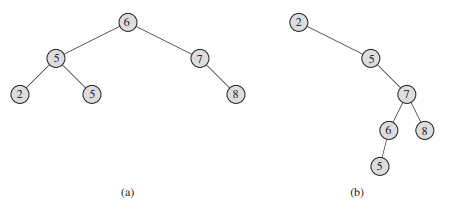Binary Search Tree
# Binary Search Trees
BST property: Let x be a node in a binary search tree. If y is a node in the left subtree of x, then y.key $\le$ x.key. If y is a node in the right subtree of x, then y.key $\ge$ x.key.

Inorder tree traversal of the BST will produce a sorted list.
# Operations
# Searching
We are able to search for a specific key in O(h) time where h is the height of the tree. The BST property allows us to perform binary search.
# Min and Max
The smallest node is rooted at the left most part of the the tree and is symmetric for the largest node.
| |
# Successors
We are able to find the successor of a node without any key comparisons:
- If there is a right subtree to the node x, the successor is the leftmost element in the right subtree
- Else, the successor is the parent of the first element which is a left child when traversing upwards through the tree.
| |
# Insert
The procedure maintains the trailing pointer y as the parent of x. After initialization, the while loop in lines 2-6 causes these two pointers to move down the tree, going left or right depending on the key comparison, until x becomes NIL. We need the trailing pointer y, because by the time we find the NIL where z belongs, the search has proceeded one step beyond the node that needs to be changed. Lines 7–10 set the pointers that cause z to be inserted.
| |